
Always an essential event in the eye care professional’s calendar, this year’s BCLA conference was particularly notable for its global reach, thanks to a very effective online platform, and for a focus upon a new initiative that is likely to play an important role in clinical life in the future.
More than 1,000 delegates from 50 different countries, across multiple time zones, checked in to the virtual event that ran continuously over two days and were able to access a wide range of presentations, seminars, exhibitions, posters and quizzes, while being able to liaise with colleagues and academics via the discussion groups.
The backbone of this year’s programme, and the topic of key lectures and discussions over the two-day event, was the recently launched research project known by its acronym CLEAR. The BCLA Contact Lens Evidence-based Academic Reports (CLEAR) were recently published in the BCLA journal, Contact Lens and Anterior Eye (CLAE), and represent a major new resource for all working in clinical practice. All of the key players in this new initiative, a cross section of expertise in contact lens science from around the world, presented an overview of each of their particular CLEAR subject areas, so making this year’s conference cast list of presenters one to remember.
As always, the conference was introduced by the BCLA president, this year Indie Grewal (figure 1), who was later to undertake a live orthokeratology fitting. This brave move was just one of many to make full use of the virtual environment to prove how an online event can be an effective alternative to face-to-face conferencing with its negative environmental and health implications. Delegates could, for example, access a virtual exhibition area (figure 2) or join in panel discussion in key topic areas (figure 3). I particularly enjoyed the online quiz, hosted by Australian-based ex-pat Dr Craig Woods, which made full use of the Kahoot! platform to combine a mix of contact lens and trivia questions to great effect; I am more than curious to know how many of our overseas colleagues are familiar with the work of Ken Dodd (figure 4).
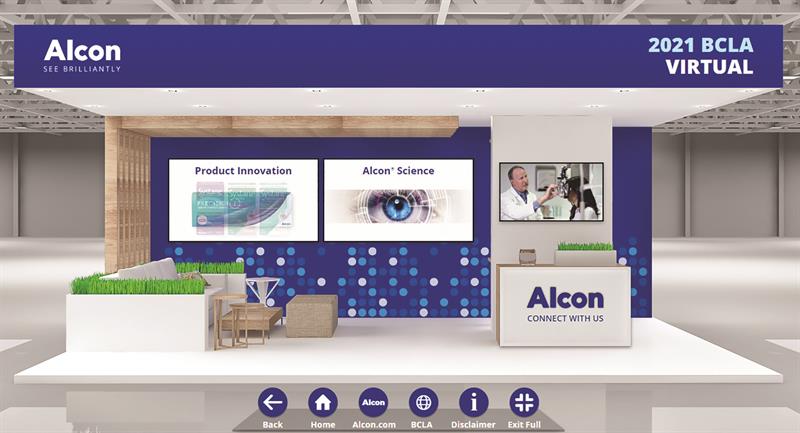 Figure 2
Figure 2
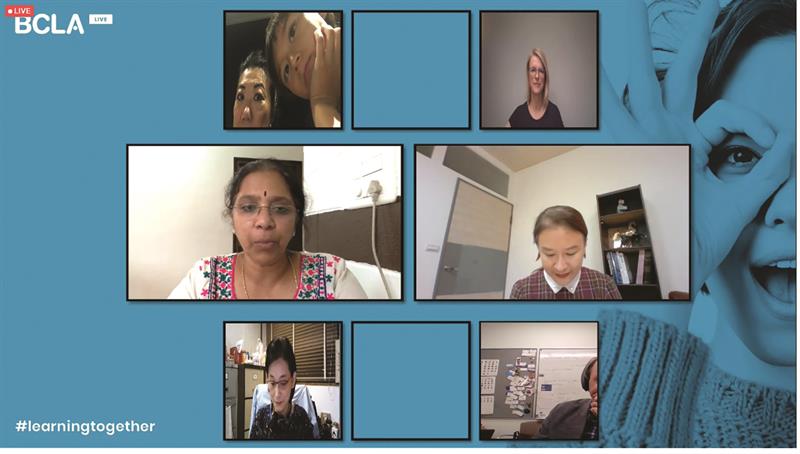 Figure 3
Figure 3
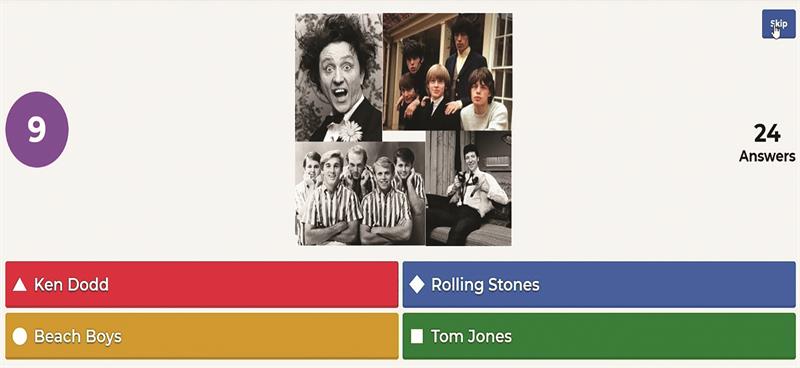 Figure 4
Figure 4
Clear project
The CLEAR project was first conceived by Professor James Wolffsohn back in June 2019, by which time he had already been a key player in the Tear Film and Ocular Surface (TFOS) publications based around dry eye disease (DEWS and DEWS2) and related topics. As readers well know by now, the extensive and
up-to-date literature reviews published by TFOS, and their recommendations and guidelines based upon these, have been important in the rapid evolution of ocular surface healthcare in recent years. It seemed, therefore, reasonable when Prof Wolffsohn suggested using a similar model for all areas of contact lens practice and the British Contact Lens Association (BCLA) executive committee agreed, giving their backing to the CLEAR project in September 2019.
In April this year, the first fruits of these reviews were published in CLAE (available as a free download at www.contact lensjournal.com/issue/S1367-0484(21)X0003-3) and were the main theme at the conference. With over 100 multidisciplinary experts involved in reviewing the published evidence base linked to all key areas of contact lens practice, this is a new resource that should significantly improve our level of care for our patients. Funding for this major project has been by way of educational grants ‘for collaboration, publication and dissemination’ provided by Alcon and CooperVision for which they deserve full credit.
Evidence
The key areas of the CLEAR project each warranted their spot on the conference agenda, usually led by the main author of the topic under discussion. So, who better than James Wolffsohn himself to launch the sessions (with Prof Phil Morgan, figure 5), to explain the overall concept and to focus on the various ways of reviewing evidence?
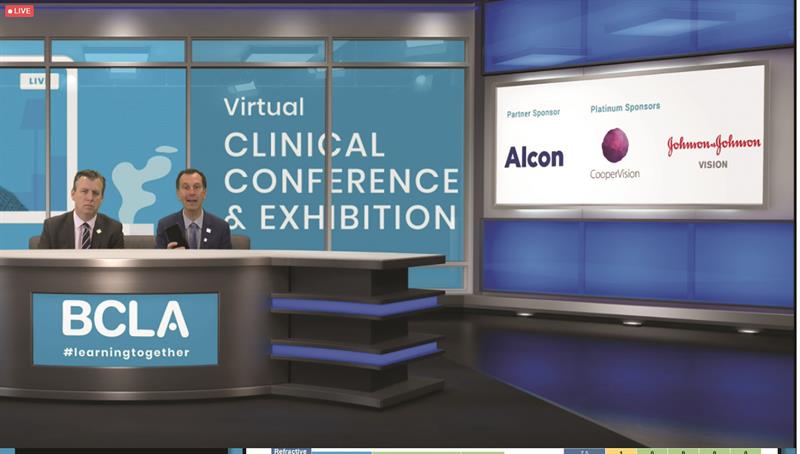 Figure 5
Figure 5
He began by underlining the three key elements of evidence-based practice (figure 6):
- The published literature
- Clinical experience
- Patient feedback
 Figure 6
Figure 6
The various, overlapping impact of each of these influence the hierarchy of evidence obtainable, represented as the now familiar pyramid with low quality and high bias-risk opinion at its base and randomised controlled trials, systematic reviews and clinical guidelines at its peak (figure 7).
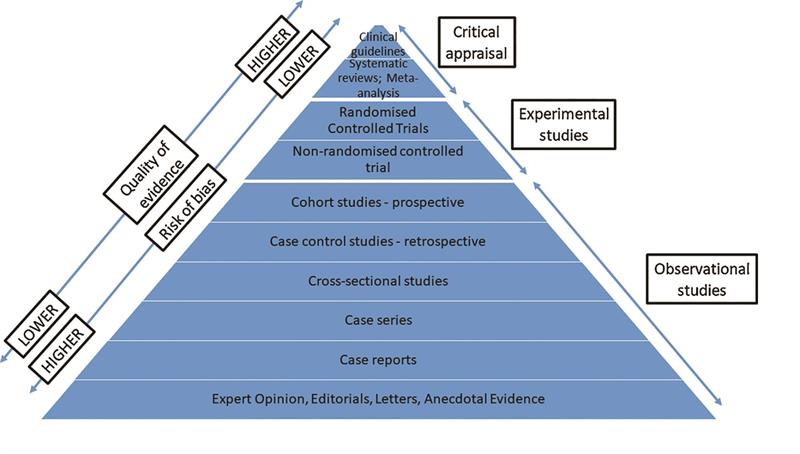 Figure 7
Figure 7
In summing up his work, Wolffsohn noted: ‘While evidence-based practice is regarded as the gold standard for clinical practice, there are some limitations. For example, trial designs may not be relevant for all management situations, individuals can vary from population norms, statistical differences are not always clinically meaningful and a patient’s environment and values need to be considered. However, ECPs owe a duty of care to their patients to apply an evidence-based approach to provide the best outcomes on the safe wear and care of contact lenses, informed by credible, scientific data.’
Impact of lens wear
The section looking at the influence of lens wear was led by Professor Phil Morgan. Much of the focus of this session was the evidence for the links between contact lenses and comfort. Morgan noted that in some areas, great success had already been achieved, perhaps most notably in the development of materials that made corneal hypoxia a thing of the past. ‘However, effects on blinking, ptosis, the function of meibomian glands, fluorescein and lissamine green staining of the conjunctiva and cornea, production of lid-parallel conjunctival folds and lid wiper epitheliopathy have received less research attention.’
There is growing evidence for the way inflammatory processes can influence lens comfort and adverse responses. ‘Contact lens wear produces a subclinical inflammatory response manifested by increases in the number of dendritiform cells in the conjunctiva, cornea and limbus. Papillary conjunctivitis is also a complication of all types of contact lenses.’ Changes to wear schedule or lens materials can minimise papillary conjunctivitis, but the impact of such changes upon dendritic cell migration ‘needs further study’. This is likely to be key in understanding the underlying mechanism for discomfort during lens wear.
Future applications
Who better to discuss the various and exciting future applications of contact lenses than Professor Lyndon Jones. And, it would seem, there are a great many on the horizon. Contact lenses capable of screening for systemic diseases, such as diabetes and cancer, or for monitoring various indicators of eye health, such as intraocular pressure, tear osmolarity, inflammatory biomarkers, retinal vasculature, limbal stem cell density, all deserve mention. The rapid progress made with digital technology has certainly made, what were once ideas from science fiction, now realisable.
Anatomy
Advances in the way tissues can be viewed and measured, not least with OCT technology, have helped improve understanding of the anatomy of the eye. This was the focus of a CLEAR session hosted by Professor Laura Downie. Of note has been the way our traditional concept of a three-layered tear film model, has now been superseded by ‘a more complex, ordered tear film structure comprising a superficial thin lipid layer overlying a thicker aqueous-mucin phase, which in turn overlies the glycocalyx (membrane bound mucins) that is tightly bound to the ocular surface epithelium.’
Similarly, our view of the cornea is that it comprises five layers. ‘There remains contention surrounding the potential existence of a postulated sixth corneal layer, Dua’s layer, located between the stroma and posterior limiting lamina.’ I remember first reporting on this some years ago and the evidence base for its existence is still in need of bolstering.
Also of significance is an understanding of the dynamic shape of the cornea through life. ‘The two posterior corneal layers are customarily presented as single values, although ranges are more accurate since their thickness changes throughout life. With age, the posterior limiting lamina becomes thicker and the endothelium thins.’
Such a review as this can never do full justice to such a major enterprise so, again, I encourage readers to download the full set of reports. Other sections, also addressed at conference, include:
- Contact lens wettability and interaction with tears
- Orthokeratology
- Contact lens optics
- Scleral lenses
- Medical use of contact lenses
- Contact lens complications
Science agenda
As always, there was a wealth of free papers and research presentations on offer. Here are some of the highlights.
- A team including Anna Sulley looked at satisfaction levels with children and teens when they were refitted with MiSight myopia lenses (M1d). Levels were high wearing M1d over three-years, whether previously adapted or new to the lens, having been refitted from progressive one day lenses. ‘Subjective responses were substantially equivalent between the two groups throughout the study, although expectations on potential visual disturbances should be managed when fitting older children adapted to single vision contact lenses.’
- A team from Montreal assessed the visual acuity, the level of high order aberrations generated and the amplitude of accommodation obtained with three multifocal soft lenses in a myopic population aged 18 to 25 years, as well as their subjective evaluation in terms of comfort and quality of vision. ‘The multifocal lenses tested all generate a high level of higher order aberrations. The impact on visual quality varies depending on the design.’ The team found that the comfilcon lens was most preferred for vision and comfort while the omafilcon lens was least preferred. They therefore concluded that the former is likely to be ‘the best option for the control of myopia in young adults.’
- An online, quantitative survey was conducted by Flamehealth in 2020 with UK-based ECPs who had been working in a practice for more than one year. They confirmed that existing single vision contact lens wearers are the most likely to be future multifocal contact lens wearers (38%). However, some 40% of their MFCL wearers had prior wear of multifocal spectacles only, 68% of whom had been wearing spectacles for less than five years. Key drivers for opting for MFCL wear were ‘concerns about the cosmetic appearance of spectacles (91%) and an active lifestyle (72%).’ On the negative side, a surprising 42% of ECPs agreed that ‘fitting MFCLs takes too much chair time’ and ‘60% would fit more MFCLs if they were quicker to fit and 38% if first fit success was higher.’ Retention of presbyopic CL wearers is also an opportunity for practices, with ‘49% suggesting drop out is within the first year of wear, 67% of those dropouts being new to CLs (40% new to vision correction, 26% from multifocal spectacles).’
- A study from Greece used a thermal camera and confirmed data that had already been found elsewhere. It seems that dry eye disease patients are shown to have a lower ocular surface temperature. The study also found that ‘no temperature interaction of dry eye disease and CL wear was observed, a phenomenon that rejects the hypothesis that contact lens wear contributes to DED, change in temperature and tear film stability in time. Interestingly though, discontinuation of wear in the CL wearers showed tear temperature instability.’ The researchers suggested that a cost-effective thermal camera should be accessible to clinicians.
- One interesting study has used a 2D Fourier analysis of images taken using meibography to calculate gland mean frequency and irregularities in growth and distribution. A total of 146 images (two images for both upper eyelids of each patient) were collected and subjectively graded by the experts and grouped into three classes: healthy (24 samples), intermediate (75 samples), unhealthy (47 samples). The data showed that the algorithmic analysis was accurate and also that pre-classification of the data improved the accuracy of the subjective grading.
- A demographics and lifestyle questionnaire was administered to 322 residents of an urban community (aged 16 to 88 years, 58% female) in a cross-sectional study overseen by Professor Jennifer Craig. Each participant underwent a comprehensive dry eye workup that included assessment of symptoms, the tear film and the ocular surface. Dry eye status was determined according to the TFOS DEWS II diagnostic criteria. Increased digital device use was observed to be a risk factor for dry eye disease, while increased caffeine intake was found to be protective.
- Professor Fiona Stapleton described how the use of a topical ointment containing selenium disulphide (labelled as AZR-MD-001 1%) appears to ‘improve meibomian gland patency and secretion in symptomatic contact lens wearers.’
- A team from Sydney has shown that increased consumption of oily fish and cereal has a small but significant effect ‘on reducing ocular symptoms and increasing tear volume respectively.’ They conclude that ‘Nutritional advice, including minimising consumption of extra food, may be helpful in the overall management of patients with symptomatic dry eye.’
Posters
I often think that some of the most useful tips for practice can be gleaned from the posters. This conference was no exception. Here are a few that caught my eye.
- A team from Alcon has looked at solutions containing myristamidopropyl dimethylamine showed significantly more cell death (p<0.05) compared to the other four multipurpose solutions for both strains of Acanthamoeba. For one strain, the solutions had 120% to 1107% more cell death compared to the other combinations of biocides. Impressive numbers. Another poster found the solutions to be effective against against Fusarium.
- A novel daily disposable silicone hydrogel lens containing moisturisers and osmoprotectants (kalifilcon A) has been found to help in maintaining ocular surface homeostasis and to provide clarity and comfort in physically active subjects, according to a poster by a B&L team.
- The team based in a hospital contact lens clinic in Belfast outlined the role of large-diameter contact lenses in managing refractive error in their patients. Clinical records of 62 patients fitted from one of eight CL trial sets of large-diameter cornea-scleral, mini-scleral and full scleral CLs, between 2016 and 2019, were reviewed. Patients with keratoconus, corneal graft surgery, corneal ring implants and dry eye proved to be most successful. Handling difficulties proved to be the main reason for lens wear discontinuation.
- Participants were randomly assigned to one of two adaptation schedules: fast (wearing for 10 hours per day from the start), or gradual wear (instructed to wear lenses for four hours on the first day, increasing by two hours per day to a maximum of 10 hours). Neophytes did not exhibit any clinically significant benefits from an adaptation period with monthly disposable lenses. ECPs should reconsider advising this restrictive wearing schedule for new patients prescribed with this contact lens modality.
- Physical stress and tear film interaction are likely factors for contact lens discomfort. Bioactive lipid mediators (LM) that are generated from omega-3 and omega-6 polyunsaturated fatty acids (PUFA) regulate ocular surface physiology and pathophysiology, are constituents of human tears and potential biomarkers. Whether silicone hydrogel lenses interact with tear LM and PUFA was investigated. Worn silicone hydrogel lenses rapidly retain and accumulate tear PUFA and established LM that regulate ocular surface physiology and pathophysiology. The marked subject and lens type differences in the lipidome may document changes in ocular surface physiology, cell activation or infection that are associated with contact lens wear. Results provide a strong rationale to investigate if contact lens discomfort and adverse events induce a specific tear and lens PUFA and LM profile and to validate their potential as biomarkers.
Prizes
Dr Keyur Patel, sometime author for this publication, was named Dry Eye Practitioner of the Year, while Sabrina Sheik picked up the award for Young Contact Lens Practitioner of the Year. John Pruitt and Erich Bauman from Alcon won the Industry Award for the Dailies Total 1 technology.
Andrew Jelly, Jonathan Jackson and Joanne Logan won the award for best poster analysing their clinic in Belfast, while Marco Tovaglia was named the winner of the Diane Gould Photography Competition.
